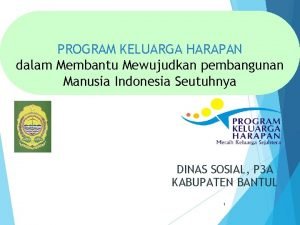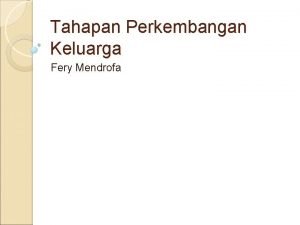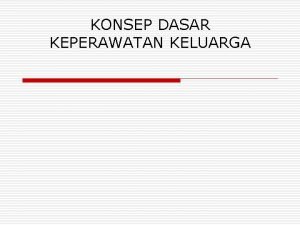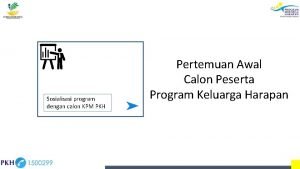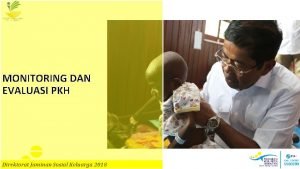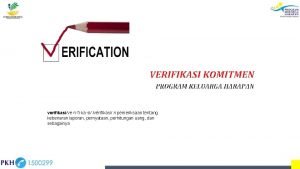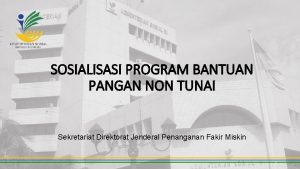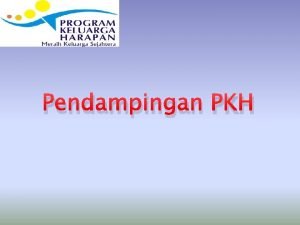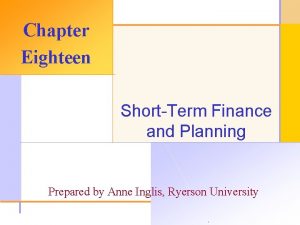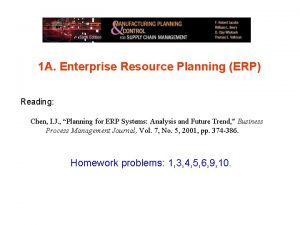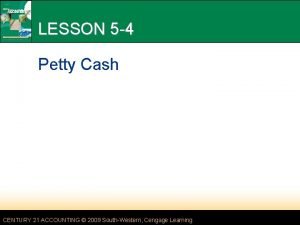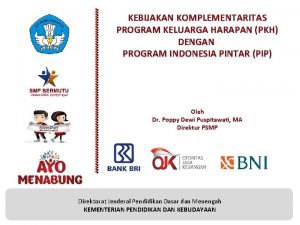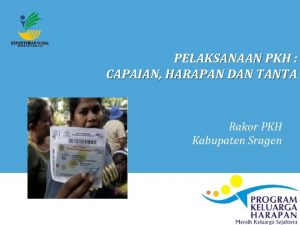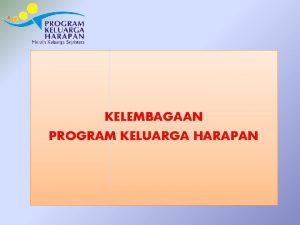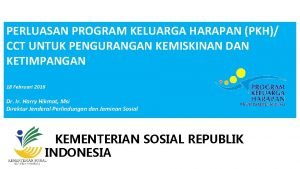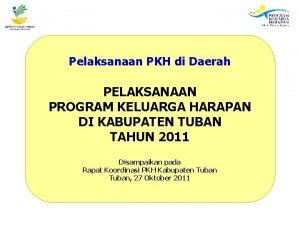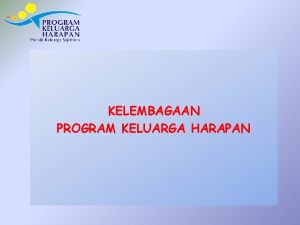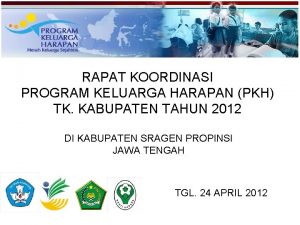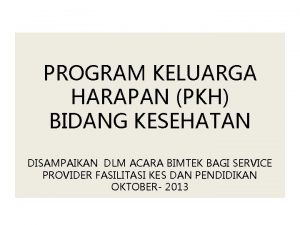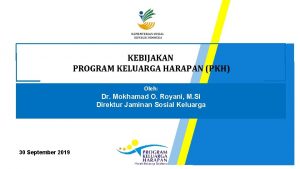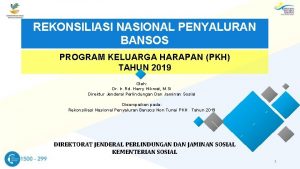CONDITIONAL CASH TRANSFER PROGRAM KELUARGA HARAPAN PKH A














- Slides: 14

CONDITIONAL CASH TRANSFER (PROGRAM KELUARGA HARAPAN – PKH) A LESSON LEARN FROM INDONESIA “International Workshop: Conditional Cash Transfers as a Tool to Address Child Labour” Manila, 11 April 2016

Outline • Child Labor Condition in Indonesia • Poverty Reduction Strategy • Background of Program Keluarga Harapan (PKH) • Contribution of PKH in reducing Child Labor in Indonesia • Space for Improvements 2

Policy Strategy on Reducing Poverty and Inequality IMPLEMENTATION APPROACH Increasing income of the poor and vulnerable (40% below) Reducing burden of the poor Inclusive growth DEVELOPING QUALITY EMPLOYMENT OPPORTUNITIES Expanding manufacturing industries for creating new employment opportunities BUILDING A COMPREHENSIVE SOCIAL PROTECTION SYSTEM Restructuring social assistance through expansion of coverage and improvement of program design, e. g. : KIP, KKS, PKH, etc. PROMOTING SUSTAINABLE LIVELIHOODS EXPANDING THE ACCESSIBILITY OF BASIC SERVICES Developing primary sectors and local potentials Expanding infrastructure and facility of basic services Formulating regulatory Expanding coverage of the framework that stimulates National Social Security for the positive investment climate vulnerable and informal workers Expanding access of the vulnerable to capital and financial services through strengthening micro financing system Facilitating the poor and vulnerable in accessing basic rights and basic services Tax Reform Strengthening skills and develop entrepreneurship Strengthening M&E system for basic service delivery Strengthening social assistance institutions and implementers (service standard, data, and referral system, etc. 3

CCT (PKH) CONCEPT 1. PKH is a social protection program targeted to poor families in the form of conditional cash transfer The main goal of PKH is to break poverty chain, by improving the quality of human resources, especially in the areas of health and education. 2. The implementation of PKH is inseparable from the succesful experience of CCT implementation in many countries Evaluations of CCT in Indonesia show to: a. Encourage poor families investing in children’s health and education improve children’s school attendance and educational achievement in the beneficiaries families b. Improve maternal and children health, reduce malnutrition c. Spillovers effect: Reduce child labor and the improvement of healthier lifestyles to the non beneficiaries in the same regions. 3. Exit Strategy Transformation/ Complementary Program, and FDS (Family Development Sessions)

Program Keluarga Harapan at Glance • Launched in 2007 as Pilot in 6 Provinces, become National Program in 2013. • Target the very poor households/families with the present of the following type of family members: – Pregnant/lactating mother – Pre-schooler (under 6 years old) – School-age children (up to Junior Secondary School) • As other CCT programs, PKH links the benefits to the compliance of the beneficiaries on required conditions • Conditionality includes: – Pregnant/lactating mother should visit Puskesmas 4 times/as required. – Pre-schooler needs to be presented at Posyandu or Puskemas for growth monitoring and nutrition supplementation – School-age children need to have monthly attendance rate at

Permanent assistance : Rp. 500. 000 (USD 38) Elementary School : Rp. 450. 000 (USD 34) Junior Highschool : Rp. 750. 000 (USD 57) Senior High School : Rp. 1. 000 (USD 76) 6

Coverage and Resources PKH Beneficieries Area of Coverage Personnels Total Province 34 Regency 443 Sub-District 5. 271 Human Resource of PKH Budget IDR. 929 IDR. 1, 282 IDR. 1, 867 IDR. 3, 536 IDR. 5, 548 IDR. 6. 471 Baseline IDR. 1, 300 IDR. 1, 600 IDR. 1. 884 IDR. 2, 711 IDR. 2. 862 IDR. 5, 222 • From 2007 to present, PKH still becomes a national priority programme in poverty elevation policy • In 2010 -2014 Long-term Development there has been an increase of beneficieries and budget allocation for PKH which surpassed planned target baseline. • 2015 it sharply increased which reached 3. 5 million targeted poorest households and IDR 6. 4 trillion on budget (USD 7, 6 million)) Personnel Total Assitant 14. 594 Operator 2000 Area Coordinator 47 Management 40 7

PKH Beneficiaries in 2015 Family Member Pregnant Mother Toddler Pre School Children Amount 100, 161 1, 544, 768 124, 485 Children of elementary school age 3, 343, 755 Children of junior high school age 1, 636, 000 Children of senior high school age 726, 014 TOTAL (icl. Pregnant Mother) 7, 475, 183 Source: PKH MIS Database, March 2016 8

Exit Strategy and Complementary Program 1. 2. PKH was designed to target poor families through conditional cash transfers which are given temporarily (6 years) in order to: Minimize the dependency of cash transfers; Open up the opportunities of other poor people who have not received PKH because of the limited budget; Lesson learned from other countries shows that program objectives can begin to be seen after 6 years. PKH Transformation as an exit strategy, to: Ensure the continuity of good behaviour of poor people resulted from PKH conditionality; Avoid retrieval dan revolving door effects after PKH beneficiaries did not received cash assistance anymore; Sustainable increase of welfare by directing necessary programs and other complementary social protection programs to PKH beneficiaries. By supporting PKH beneficiaries with several programs (from central and local government), it was expected that they can accumulate and allocate assets to more productive activities in order to get out of the poverty trap.

Contribution of PKH in Addressing Child Labor

Efectivity of PKH Education World Bank, 2010 Increase of school hours by 0. 7 hour per week for Secondary School Students Increase school hours by 20 min per week for Primary School TNPK, 2014 Decrease of drop out rate at Primary School by 1. 2 % Increase of school participation/enrolment rate at Secondary School level by 5% Child Labour/Worker World Bank, 2010 Reduce incident of child labour/worker by 0. 6% TN 2 PK, 2014 Reduce of child labour prevalance by 3. 9% Spillover Household Consumption World Bank, 2010 Increase of consumption almost by 10% of average montly expense Indicators of nutritous food consumption (meat, fish, egg, milk) increased by 0. 75 % Worldbank, 2010 Increase of pre-natal examination among neigbours who don’t receive PKH by 4% Increase of child weighning among neigbours who don’t receive PKH by 7% Almost 8% of PKH participants’ neighbour perform childbirth through support of medical workers 11

Education-related Outcomes • On midline evaluation, impact of PKH on most, if not all, of education outcomes were insignificant • On endline evaluation, impact PKH can be observed on gross enrollment for primary and secondary school and particularly on transition from 6 th to 7 th grade. • Primary school aged children from beneficiary families were found to be more likely to stay at school as their drop-out rates were 1. 6 percentage points lower than their counterparts from non-beneficiary families. • The probability of children aged 13 -15 from beneficiary families participating in school was 9. 5 percentage points higher than for their counterparts from non-beneficiary families. Source: TNP 2 K Evaluation Endline

Space For Improvements • Unified Data Base • Integrated and Comprehensive Program • Strengthening the Coordination Between Institution in National and Regional Level • Including Child Labor Reduction Objectives in PKH Goals • Strengthening Family Development Session

TERIMA KASIH THANK YOU 14
 Program keluarga harapan
Program keluarga harapan Tahapan keluarga
Tahapan keluarga Sejarah keperawatan keluarga
Sejarah keperawatan keluarga Susunan acara pkh
Susunan acara pkh Siapa yang mendata pkh
Siapa yang mendata pkh Zimbra mail bea cukai
Zimbra mail bea cukai Formulir verifikasi pkh
Formulir verifikasi pkh Nomor pkh terletak dimana
Nomor pkh terletak dimana Pengertian pendamping
Pengertian pendamping Cash to cash cycle time
Cash to cash cycle time Cash to cash cycle time
Cash to cash cycle time What is cash in and cash out
What is cash in and cash out The essentials of effective budgeting do not include
The essentials of effective budgeting do not include Paid cash to establish a petty cash fund
Paid cash to establish a petty cash fund Chapter 5 cash control systems answer key
Chapter 5 cash control systems answer key
